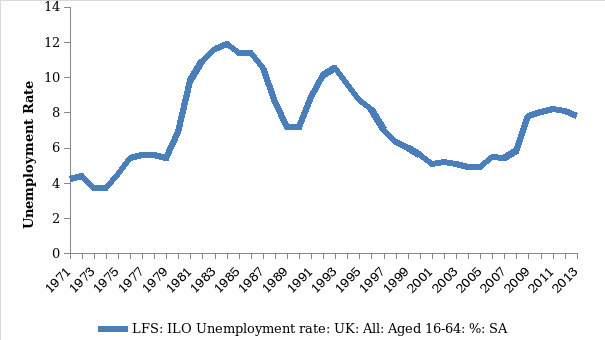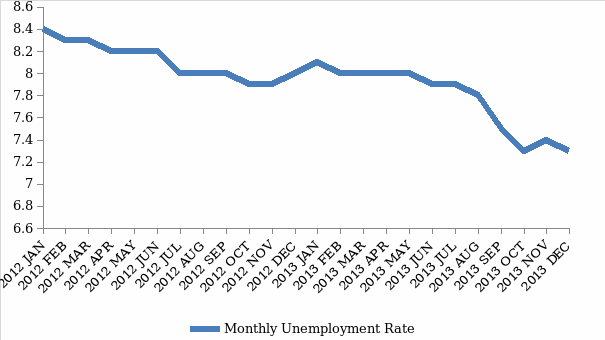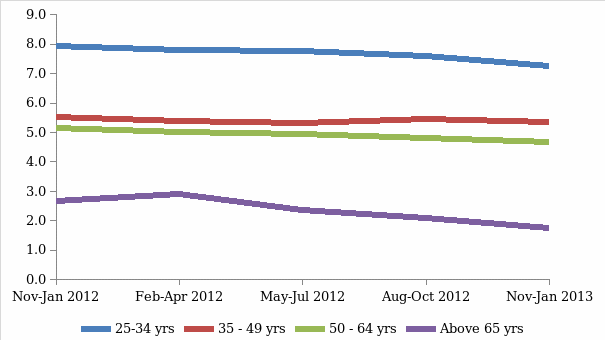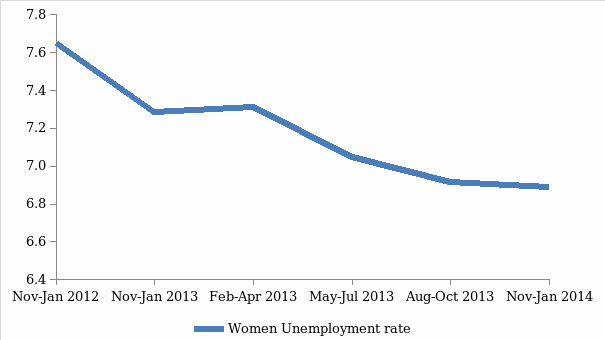Employment in the UK has shown a positive sign that many believe to be a mark of an economic turnaround. The unemployment rate has fallen considerably, and the rate of employment of women and that of youths has increased (UK unemployment falls by 125,000 to 2.34 million).
Analysts believe that the unemployment data presented by the Office of National Statistics (ONS) demonstrate that the rise in employment level demonstrates a strengthening of the fundamentals of the economy. This essay studies the change in the unemployment rate in the UK and the underlying reasons behind it.

Historically, since 1971, the unemployment rate had reached the lowest in 1973 and then again in 2005-06. However, the unemployment rate had climbed down from 2012 through 2013 (see figure 1). A closer look at the 2012-13 monthly data reveals that the unemployment rate in the UK has been continually declining since January 2012, except for a brief period from November 2012 to January 2013. From January 2012 to December 2013, the unemployment rate has declined by 13 percent from 8.4 percent to 7.3 percent, respectively (ONS).

A decline in the unemployment rate indicates the strengthening of the economy. Further, there has been a decline in the rate of people who are underemployed, increased long-term employment. Further, the wage rate to has shown a sign of increase. However, analysts believe that the increase in wage rate is not comparable with the increase in price inflation, which has reduced real income (Monaghan).
In 2014, the effect on real wages had eased marginally, with a fall in inflation by 2 percent (UK unemployment falls by 125,000 to 2.34 million). However, the fall in the unemployment rate has slowed down at the beginning of 2014, according to the data released by ONS (UK unemployment falls by 125,000 to 2.34 million). However, economists have grown apprehensive of the decline in the rate of fall in the unemployment rate in 2014, which was reduced from 7.2 percent decline to 7.1 percent.
Though, the most meaningful results can be drawn from quarterly figures for variation in monthly figures can be, at times, misleading. However, analysts believe that there has been a slowdown in the rate of fall of the unemployment rate (UK unemployment falls by 125,000 to 2.34 million).
In order to understand why there has been a decline in the unemployment rate in the UK, it is essential to understand the reasons affecting UK unemployment. Economic recession causes a cyclical deficiency in demand, resulting in a fall in the real GDP. A fall in aggregate demand in the economy causes a fall in production, reducing the demand for labor, hence, increasing unemployment. Further, structural change in the economy can reduce employment in the economy.
Youth unemployment is usually high as they lack skillsets for employment. Figure 3 shows that the unemployment rate among youths has decreased considerably. From January 2012 to January 2014, there has been 11.6 percent decline in the unemployment rate in the age group of 25-34 years. In the age group of 35-49 years, the unemployment rate in the above period has declined by 16 percent (ONS). This is a good sign as it indicates that long-term employment will increase, as more youth have found a place in the workforce.

Recent analysis suggests an increase in women’s employment in the UK. Women’s unemployment has declined considerably (UK unemployment falls by 125,000 to 2.34 million). Figure 4 shows the unemployment rate of women from 2012 to January 2014. This indicates that the unemployment rate of women has declined considerably. Overall, there has been a decline in 4 percent in the unemployment rate of a woman from 2012 and 2013, which is lesser than a decline of 9 percent among men and over the decline of 7 percent (ONS).

A detailed analysis of the change in unemployment rate based on age group shows that women unemployed in the age group of 25-34 has declined by 10 percent in 2013 as compared to 2012, while that of men has declined by 2 percent (ONS). In the age group of 35 to 49 years, the decline has been by 14 percent among men and 12 percent increase among women (ONS).
Such a sharp decline in the unemployment rate of women indicates that increasingly younger women are employed in the workforce. Though time-series data would show that the unemployment rate among women has declined considerably compared to the previous years, the overall decline is much less than the total decline in the unemployment rate.
The analysis shows that overall, there has been a decline in the unemployment rate in the UK from 2012 through 2014. However, the decline is more in the age group of 35 to 49. Further, there has been a decline in the unemployment rate of the age group 25 to 34. Further, women unemployment has contributed to the maximum decline in unemployment in this age group. Women’s unemployment has declined, but the decline is much less than the overall decline in unemployment.
Works Cited
Monaghan, Angela. “UK unemployment – what the economists say.” 2014. The Guardian. Web.
ONS. “Labour Market Statistics.” 2014. Office of National Statistics. Web.
“UK unemployment falls by 125,000 to 2.34 million.” 2014. BBC News. Web.